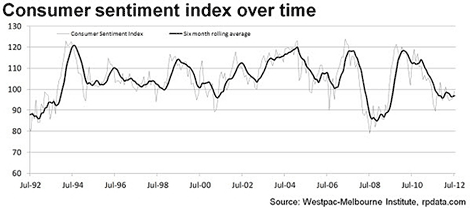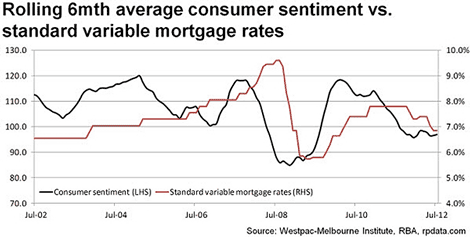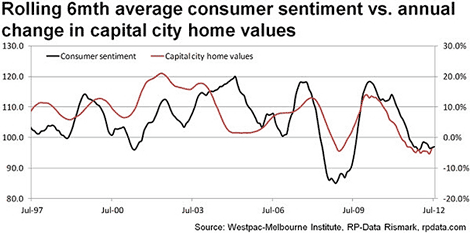Slow rise in consumer sentiment shows interest rate cuts no longer have same influence: Cameron Kusher

Westpac and the Melbourne Institute's consumer sentiment index was recorded at 99.1 points for July, which indicates that consumer sentiment is close to the neutral mark where optimism and pessimism are equally weighted (i.e. an index reading of 100).
The consumer sentiment index continues to point to a higher level of pessimism than optimism despite the fact that there has been a significant decline in the standard variable mortgage rate over recent months (the index has remained under the 100 mark since March 2012).
The recent round of interest rate cuts commenced in November 2011 and since that time average mortgage rates have fallen by a total of 95 basis points. In October 2011, the month prior to the first interest rate cut, consumer sentiment was recorded at 97.2 points. Despite 95 basis points worth of interest rate cuts since that time, sentiment is just 1.9% higher. Consumers simply aren’t responding to lower interest rates in the way they have in the past.
Click to enlargeClearly in the current economic environment of global and domestic uncertainty a lower interest rate environment is not proving to be enough to encourage a higher level of consumer optimism. Although there has been an improvement in all components of the consumer sentiment index over recent months, respondents are particularly pessimistic about family finances over the past year and over the coming year. This result suggests that although lower interest rates should ease financial burdens on families other factors are leading to lower expectations of finances. You could speculate that it is probably related to factors such as the carbon tax, political concerns both domestically and internationally, concerns of a Chinese economic slowdown and ongoing concerns about key European economies.
We also know that unlike conditions prior to the Global Financial Crisis (GFC) the behaviour of consumers has changed significantly. For starters, households are saving a lot more than they were previously. The household savings ratio was in steady decline since the mid-1970s and in 2003/04 households were actually spending more than they were earning (i.e. savings was negative). The household savings ratio has rapidly risen and has been above 8% since December 2008. Private sector thirst for credit, both housing and non-housing has also dried up. Total private sector credit growth was recorded at 4% over the year to May 2012 compared to typical annual growth over the past 20 years of 9.6%. Annual growth in housing credit is currently at a historic low of 5.1% over the year to May 2012 compared to typical annual growth of 13.4% over the past 20 years. Other indicators such as growth in spending on credit cards, housing finance commitments, retail trade and dwelling approvals are also reflective of limited demand from consumers to spend and a renewed focus on saving and debt reduction.
The lacklustre response to the significant easing of variable mortgage rates has repercussions for the housing market. Despite such a significant easing in mortgage rates, capital city home values have fallen by a further -2.2% since October 2011. It is important to note that values did increase by 1% in June and, based on the daily movements in the RP Data-Rismark Home Value Index, have now been trending higher over the past six weeks.
As the graph shows, over recent years consumer sentiment has been an important element of the performance of growth (or declines) in home values and, as a result, a sustained improvement in home values is likely to be dependent on a sustained improvement in consumer sentiment.
Click to enlarge Sales transaction data lags our value data. However, volumes have also shown little response to date to a lower mortgage rate environment. As the graph shows, consumer sentiment and sales volumes have recorded quite a strong correlation in recent years. A sustained recovery in consumer sentiment is therefore likely to result in an improvement in residential sales activity.
Click to enlarge
Overall, cuts to mortgage rates take some time to filter through to the market, but capital city home values have now been increasing over the past six weeks. Sales volumes data which does lag is yet to show signs of a recovery and the amount of stock available for sale is slowly easing. We may well see further improvement in sales activity in the spring, which is typically a busier time for the housing market.
The key ingredient to an improvement in the housing market is likely to be an ongoing and sustained improvement in consumer sentiment, particularly a willingness to spend on high commitment purchases. This is likely to take some time, given the high level of caution being shown by consumers and the ongoing global economic uncertainty.
Click to enlargeCameron Kusher is senior data analyst at RP Data.
This article originally appeared on SmartCompany in July.



